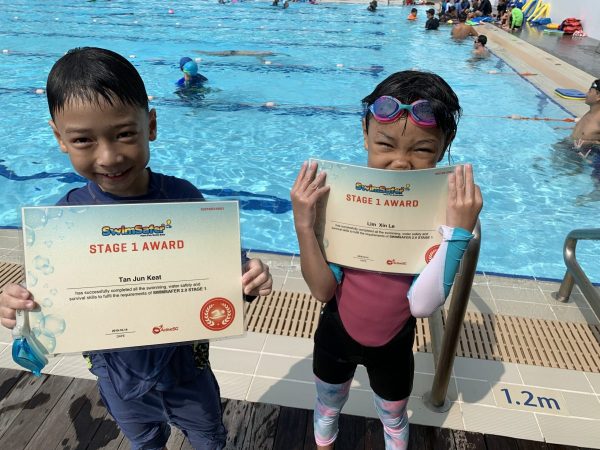SwimSafer is a national water safety programme that draws on elements of the National Survival Swimming Award (NASSA) and Learn-to-swim (LTS) programme. Introduced in July 2010 by the National Water Safety Council (NWSC), it aims to progressively teach children swimming and water survival skills over six stages. Upon the successful completion of each stage, the child will receive a certificate detailing his/her skill achievements.
Each of the six stages progressively imparts skills in the following areas.
- Entries / Exits
- Sculling and Body Orientation
- Underwater Skills
- Movement / Swimming strokes
- Survival Skills
- Rescue Skills
- Knowledge
Stage 1: Introduction to water skills
This stage of the programme seeks to build water confidence and impart water safety knowledge to the child. In addition, it introduces forward and backward movement along with safe entry and exit techniques.
Stage 2: Fundamental water skills
The knowledge and skills learnt at this stage are built upon those that were acquired in Stage 1. New skills that are taught at this stage include unassisted step entry, sculling, feet first surface dives and personal water safety skills. The child will also be required to be able to swim 25 metres continuously.
Stage 3: Personal and Stroke Development Skills
At this stage, the child will learn personal survival skills and some basic rescue skills. Skills taught in Stage 2 of the programme such as sculling and underwater skills will be further developed here. The child will also learn how to use a personal flotation device. At this stage of the programme, the child should be able to swim 50 metres continuously.
Stage 4 (a.k.a Bronze): Personal Survival and Stroke Improvement Skills
This is where the child’s swimming strokes and breathing techniques will be developed. Throughout this stage, children will build up their stamina and work towards swimming 100 metres continuously. Also, personal survival skills and basic rescue skills will be further developed. At the same time, knowledge of watercraft safety will be introduced.
Stage 5 ( a.k.a Silver): Intermediate Personal Survival and Stroke Refinement Skills
This is the point where the fundamentals of diving will be introduced. Advancements in the level of rescue skills and personal survival knowledge are to be expected and children should be able to demonstrate efficient stroke techniques by the end of this stage.
Stage 6 (a.k.a Gold): Advance Personal Survival and Swimming Skill Proficiency
SwimSafer Gold is the final stage of the programme and children will have to perform strokes with relative finesse over 400 metres. Standing dive and personal safety skills will continue to be imparted at this stage in addition to rescue skills and water safety knowledge
To learn more about our Swimsafer syllabus, you may visit our page here.
 SwimInSG
SwimInSG SwimInSG
SwimInSG